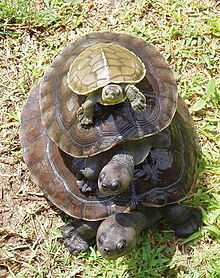Chinese stripe-necked turtle
| Chinese stripe-necked turtle | |
|---|---|
 | |
| Conservation status | |
| Scientific classification | |
| Kingdom: | Animalia |
| Phylum: | Chordata |
| Class: | Reptilia |
| Order: | Testudines |
| Suborder: | Cryptodira |
| Superfamily: | Testudinoidea |
| Family: | Geoemydidae |
| Genus: | Ocadia (previously Mauremys) |
| Species: | O. sinensis |
| Binomial name | |
| Ocadia sinensis (Gray, 1834) | |
| Synonyms[2] | |
| |
The Chinese stripe-necked turtle (Ocadia sinensis) or golden thread turtle, is a species of turtle in the Geoemydidae family.
Like many other Geoemydidae, this species hybridizes vigorously with related and not-so-closely related members of its family.
It is one of the two most commonly found species used for divination that have been recovered from Shang dynasty sites.[3]
Habitat
Chinese-stripe-necked turtles have a green body. As a juvenile, it's carapace is grayish green and there are three distinctive ridges. As an adult, the color fades to a brown color and the two ridges gradually disappear. The plastron is ivory in color with small black spots. The male's tail is more coarse and long, while adult females will be larger than the males.
Distribution
It is found in China (Hainan, Guangdong & Fujian), Taiwan, Laos and northern & central Vietnam.
Habitat
This species prefers low altitude waters such as ponds, canals, and slow-moving rivers.
Conservation
Chinese stripe-necked turtles are protected by the CITES and IUCN, captive-breeding Chinese stripe-necked turtles are approved. Another reason that affects it's population is the invasion of red-eared sliders. In Hong Kong, mainland China and Taiwan and in some other countries, it is a popular pet turtle.
Hybridization
In captivity, hybrids have been produced between this species and Japanese pond turtle and the Chinese pond turtle, as well as with a male Cyclemys (oldhami) shanensis. The supposed species Ocadia glyphistoma is a hybrid between a male O. sinensis and a female Vietnamese pond turtle. A species nearly extinct in the wild. Ocadia philippeni was also shown to be of hybrid origin, a male Ocadia sinensis with a female Cuora trifasciata. Both are either naturally occurring or bred for the pet trade. Any individuals that are available as pets therefore need to be kept separate from other members of the family to prevent hybridization.
Reproduction
After mating, the female turtle may lay 5-20 eggs that hatch about 60 days when needed.
Footnotes
- ↑ Asian Turtle Trade Working Group (2000). "Ocadia sinensis". IUCN Red List of Threatened Species. Version 2010.3. International Union for Conservation of Nature. Retrieved 2010-10-27.
- ↑ Fritz Uwe; Peter Havaš (2007). "Checklist of Chelonians of the World". Vertebrate Zoology 57 (2): 234. ISSN 18640-5755. Archived from the original on 2010-12-17. Retrieved 29 May 2012.
- ↑ Keightley (1979), see especially pp. 160, 189-194.
References
- Asian Turtle Trade Working Group (2000). Ocadia sinensis. 2006. IUCN Red List of Threatened Species. IUCN 2006. www.iucnredlist.org. Retrieved on 29 July 2007.
- Buskirk, James R.; Parham, James F. & Feldman, Chris R. (2005): On the hybridisation between two distantly related Asian turtles (Testudines: Sacalia × Mauremys). Salamandra 41: 21-26. PDF fulltext
- Keightley (1979): Sources of Shang History: The Oracle-Bone Inscriptions of Bronze Age China. David N. Keightley. University of California Press. 1979.
| |||||||||||||||||||||||||||||||||||||||||||||||||||||||||||||||||||||||||||||||||||||||||
| ||||||||||||||||||||||||||||||||||||||||||||||||||||||||||||||||||||||||||||||||||||||||||||||||||||||||||||||||||||||||||||||||||||||||||||||||||||

